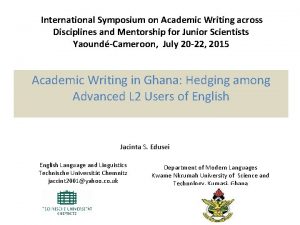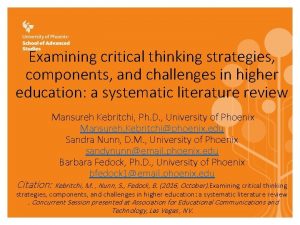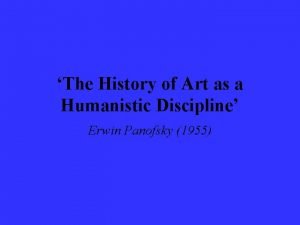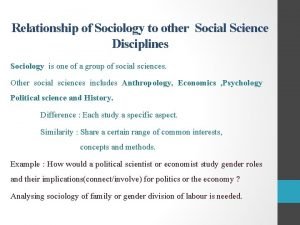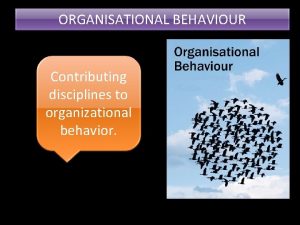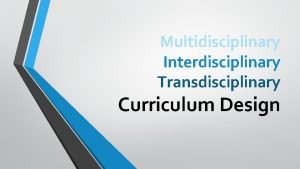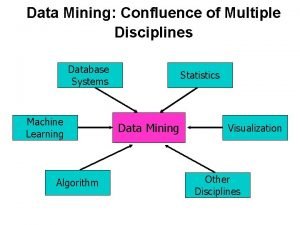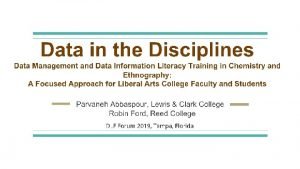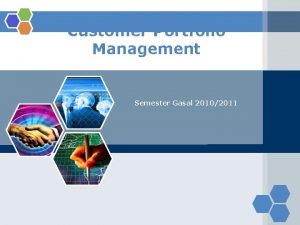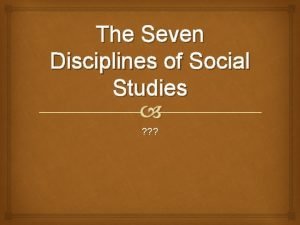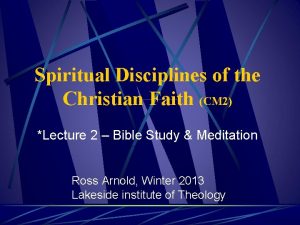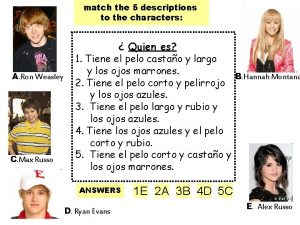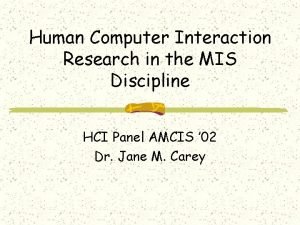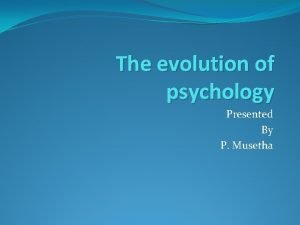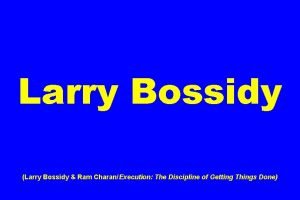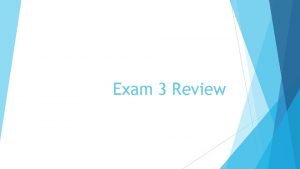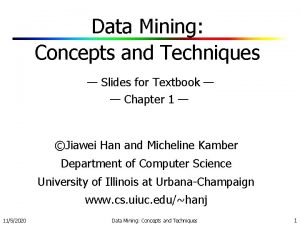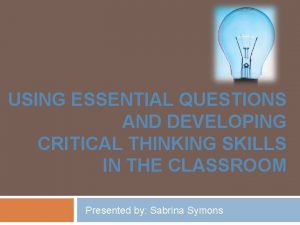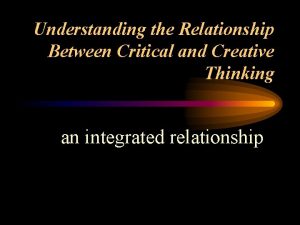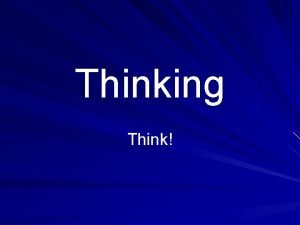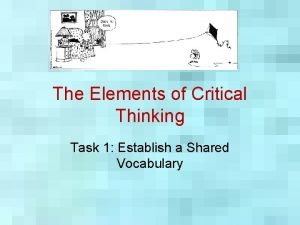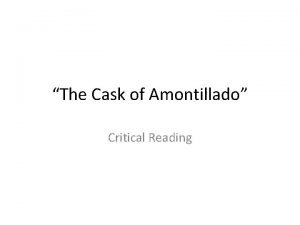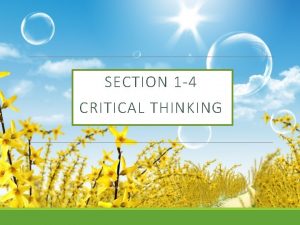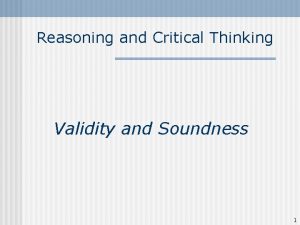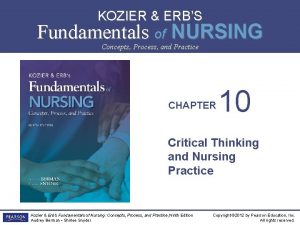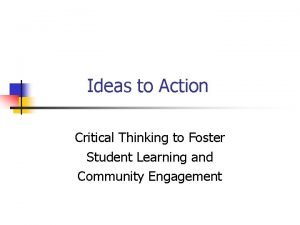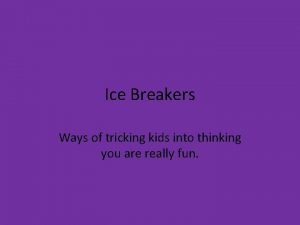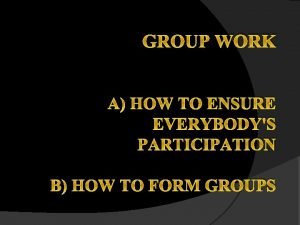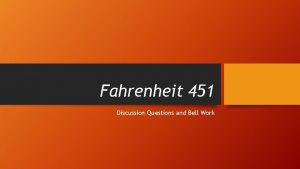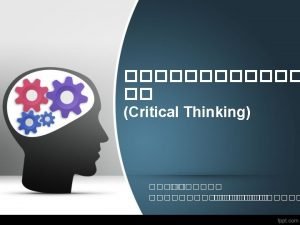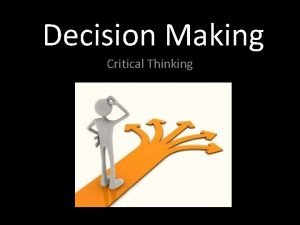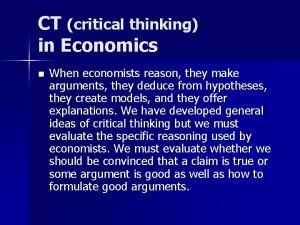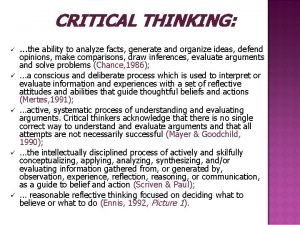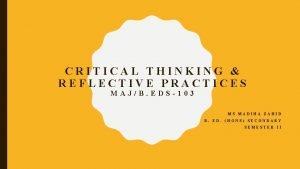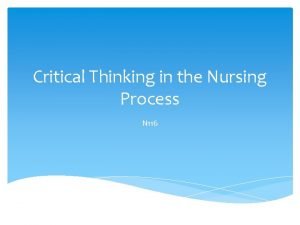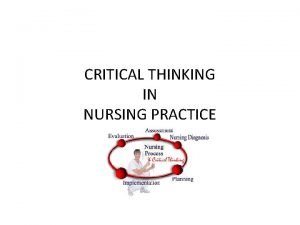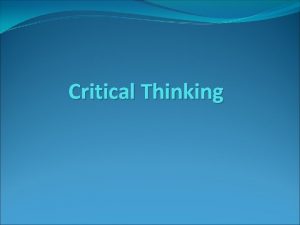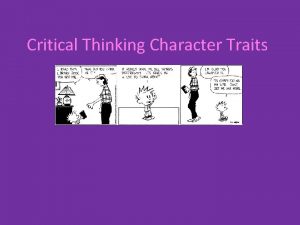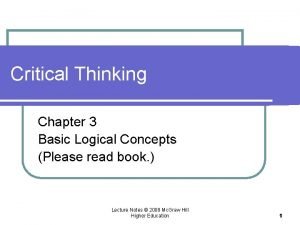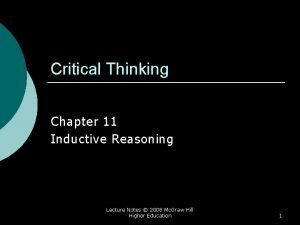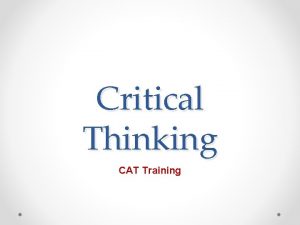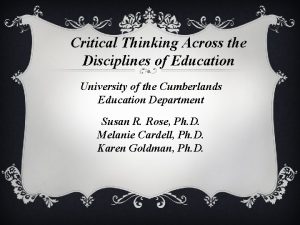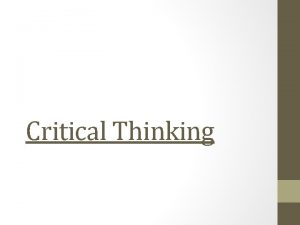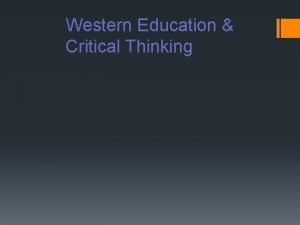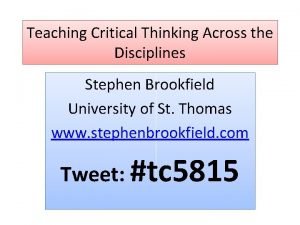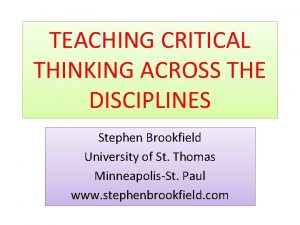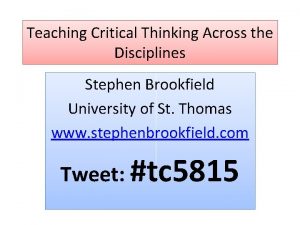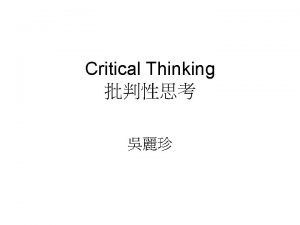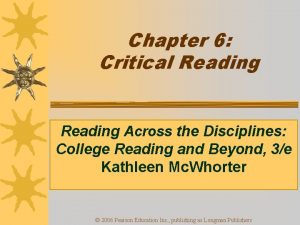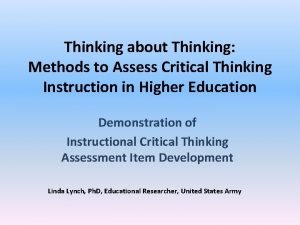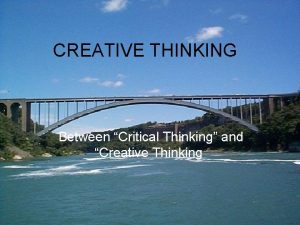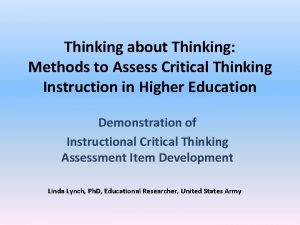Critical Thinking Across the Disciplines of Education University


























































- Slides: 58

Critical Thinking Across the Disciplines of Education University of the Cumberlands Education Department Susan R. Rose, Ph. D. Melanie Cardell, Ph. D. Karen Goldman, Ph. D.

UC University of the Cumberlands Departmentof of. Education Department of Education Departmentof of. Education Department Reflective Constructors of Quality Learning Experiences Through Critical Thinking University of the Cumberland’s Quality Enhancement Plan, 2003 -2013 Critical thinking was targeted because it is consistent with our mission statement’s commitment to encourage students to think critically and creatively First Cadre was in 2005 -2006 This presentation represents years of program review and enhancement as we are in the 6 th Cadre. School Counseling Program

UC University of the Cumberlands Departmentof of. Education Department of Education Departmentof of. Education Department Reflective Constructors of Quality Learning Experiences Through Critical Thinking Course Selection COOL 530, Introduction to School Counseling, was selected as a course in which to implement the Quality Enhancement Plan during the Fall semester of 2011, because critical thinking is naturally inherent to both education and counseling. As this is the introductory course, the thought structure was to begin the program on a good footing of critical thinking. The basic concept in this introductory course is to operationalize the concept of combining the candidate’s background in education or mental health with the more unique role of counseling through the University's Quality Enhancement model of critical thinking as well as the Education Department’s theme of Reflective Constructors of Quality Learning Experiences through Critical Thinking. School Counseling Program

UC University of the Cumberlands Departmentof of. Education Department of Education Departmentof of. Education Department Reflective Constructors of Quality Learning Experiences Through Critical Thinking Implementation of Cadre Measures Activities that are already included as core components in COOL 530, Introduction to School Counseling, are: 1. Discussion Forums. Discussion Forum 1 will serve as the Pretest measure for critical thinking, critical reading and critical writing. Other Discussion Forum activities will serve as learning/practice of critical thinking, critical reading and critical writing. 2. Research-Based Discussion Paper. The Research-Based Discussion Paper will serve as a learning/practice of critical thinking, critical reading and critical writing. 3. Philosophy of Counseling. The Philosophy of Counseling will serve as the Post-test measure for critical thinking, critical reading and critical writing. School Counseling Program

UC University of the Cumberlands Syllabus Review Departmentof of. Education Department of Education Departmentof of. Education Department Reflective Constructors of Quality Learning Experiences Through Critical Thinking The following components were added to the syllabus to draw attention to the concepts of the QEP/CATC initiative: Within the Course Requirement section of the syllabus, the following sections were inserted to identify which activities/assignments were part of the QEP/CATC measurements: § Discussion Forum 1 will serve as the Pretest measure for critical thinking, critical reading and critical writing, so be sure to address all three as discussed in the QEP/CATC Information section as well as provide a thorough reflection/answer to the response question. § The Research-based Discussion Paper will serve as a learning/practice of critical thinking, critical reading and critical writing, so be sure to address all three as discussed in the QEP/CATC Information section as well as provide a thorough philosophy as guided by the rubric. (No formal scores will be reported as this is a practice/feedback piece. ) § Your Philosophy of Counseling will serve as the Post-test measure for critical thinking, critical reading and critical writing, so be sure to address all three as discussed in the QEP/CATC Information section as well as provide a thorough philosophy as guided by the rubric. The QEP Plan provides explanation of the QEP as well as definitions of the essential elements that serve as the foundation for critical thinking. School Counseling Program

UC University of the Cumberlands Departmentof of. Education Department of Education Departmentof of. Education Department Reflective Constructors of Quality Learning Experiences Through Critical Thinking Methodology Research Design The purpose of this study as defined by the QEP/CATC was to explore students’ progress and “changes in students’ critical thinking skills as measured …. (through) embedded and formative assessments” (QEP Cadre Information Booklet, 2011). As expected by the cadre parameters, this study utilized pre and post assignments to measure critical thinking in the areas of reading, writing and information literacy. These assignments were evaluated with the common rubrics devised by the cadre. In order to address critical thinking across the curriculum, specifically the school counseling curriculum in this case, this study will: Score and record the skill level of all candidates on the pre-test activity, Discussion Forum 1, in order to provide a baseline score before studying and discussing critical thinking; Provide instruction, opportunities for discussion, and practice in critical thinking; Score and record the skill level of all candidates on the post-test activity, Philosophy of Counseling, in order to provide a final score after studying and discussing critical thinking; and Report the findings. School Counseling Program

UC University of the Cumberlands Methodology Sample Departmentof of. Education Department of Education Departmentof of. Education Department Reflective Constructors of Quality Learning Experiences Through Critical Thinking As mentioned in the introduction, this particular portion of the QEP study used the school counselor candidates from the Fall 2011, Session 1, course section of COOL 530, Introduction to School. Rubric Earlier cadre members developed a rubric from an aggregation of earlier rubrics that measures critical reading, critical writing and information literacy on individual rubrics Section I of the rubric measures clarity across the critical thinking areas of reading comprehension, writing communication and information. Section II measures discernment across the critical thinking areas of reading comprehension, writing communication and information. Section III measures integration across the critical thinking areas of reading comprehension, writing communication and information. School Counseling Program

UC University of the Cumberlands Departmentof of. Education Department of Education Departmentof of. Education Department Reflective Constructors of Quality Learning Experiences Through Critical Thinking: Reading and Writing, Information Literacy Rubric School Counseling Program

UC University of the Cumberlands Departmentof of. Education Department of Education Departmentof of. Education Department Reflective Constructors of Quality Learning Experiences Through Critical Thinking Integration of Critical Thinking Strategies Instructions for Pre-Test No instruction was provided regarding expectations for the assignment beyond the actual assignment within the discussion forum other than briefly mentioning it during the chat session as we reviewed the syllabus. The aim of this approach was to gain an accurate benchmark of where the students stand when thinking independently about how to complete a critical thinking assignment. Instruction following Pre Test Following the Discussion Forum within week one for the pre test, the professor provided an explanation of the University of the Cumberlands’ Quality Enhancement Plan: Critical Thinking Across the Curriculum. The Power Point titled How Do You Know was presented to discuss using correct sources of knowledge as well as to discuss the terms clarity, discernment, and integration. The rubric was also included on the Power Point and reviewed with the students to explain how they were evaluated in terms of critical thinking. School Counseling Program

HOW DO YOU KNOW? YOU KNOW, BUT THE REAL QUESTION IS. . HOW DO YOU KNOW?

HOW CAN YOU BE SURE. . l THERE IS NO “LITTLE MAN” INSIDE YOUR COMPUTER MAKING IT DO THE THINGS IT DOES?

HOW DO YOU KNOW. . l George Washington was the first president of the United States? l You REALLY have a stomach?

WHAT MAKES YOU SO SURE. . l THE SUN WILL RISE TOMORROW MORNING?

HOW DO YOU KNOW. . l THE COLOR OF THE SHIRT I’M WEARING?

ARE YOU SURE. . . l YOU DON’T HAVE A BIG HOLE IN THE BACK OF YOUR PANTS?

SOURCES OF KNOWLEDGE l Logic – There is no way to absolutely refute the computercreature hypothesis; but, it doesn’t seem logical and we can open up the computer and see the wires, etc.

SOURCES OF KNOWLEDGE l Authority – we know (or believe) that Washington was the first president because we trust the authority of historians and history books. Reasoning – l Deductive: “All humans have stomachs; I am human; therefore, I have a stomach. ” l Inductive: “The sun rose today, yesterday, the day before and for as long as anyone can remember. ” l

SOURCES OF KNOWLEDGE The Scientific Pair

SOURCES OF SCIENTIFIC KNOWLEDGE All these ways of knowing –authority, reasoning, observation and inference – are used by scientists. l The only basis for scientific knowledge, however, is observation and inference. l Science puts greater emphasis on evidence produced by the senses than on the authority of others or on reasoning. l

Essential elements that serve as the foundation for critical thinking Clarity – Critical thinking includes the ability to identify information specifically and accurately. Critical thinkers learn to recognize the major points of whatever they read or hear. When writing about what they have read or heard, students formulate clear, concise, and logical arguments. To fully understand a work, students recognize the need for secondary sources. A key question for clarity is, “Do I understand the basic information supplied by the author? ”

Essential elements that serve as the foundation for critical thinking Discernment – Critical thinking includes the ability to analyze information with insight and judgment. This type of analysis requires that students recognize the adequacy and credibility of primary and secondary sources, demonstrate cogent planning and organization in the writing process, and use appropriate sources. A key question for discernment is, “How can I express my interpretation in a coherent manner and choose secondary sources to enhance my own analysis? ” l

Essential elements that serve as the foundation for critical thinking Integration – Critical thinking includes the ability to evaluate and synthesize information efficiently and effectively. That means students must be able to extrapolate credible information to use in a different setting, to present fairly another’s point of view based upon the facts and analysis of the secondary source, and to have a purpose for integrating the researched information. A key question regarding integration is, “How can I incorporate appropriate secondary sources in an effective and reasonable way into my own critical analysis? ” l

UC University of the Cumberlands Departmentof of. Education Department of Education Departmentof of. Education Department Reflective Constructors of Quality Learning Experiences Through Critical Thinking Results Resultant Sample • The demographics of the school counselor candidates was quantified using data from My. UC. Of the 31 school counselor candidates within the course, 90. 32% (n = 28) identified themselves as Caucasian or European American. 3. 23% (n = 1) identified themselves as African American, while 6. 45% percent (n = 2) chose not to disclose their ethnicity. Of the 31 candidates, 77. 42% (n = 24) were female, while 22. 58% (n = 7) were male. The score reports were divided into all component parts on both pre-tests and post-tests for analysis: • Clarity Discernment Integration Reading Comprehension Written Communication Information Literacy As this is an ongoing study, culminating October 21, 2011, final results aren’t available, but I have been impressed with the increased caliber of work from this group given the Critical Thinking component. School Counseling Program

UC Departmentof of. Education Department of Education Departmentof of. Education Department University of the Cumberlands Reflective Constructors of Quality Learning Experiences Through Critical Thinking Score Report: Pre-test, Clarity COOL 530 Reading Comprehension Written Communication 8 7 Score Report: Pre-test, Discernment COOL 530 Reading Comprehension Written Communication Information Literacy Discernment Average 8 6 8 8 5 5 7 4 4 8 8 6 5 8 6 4 5 6 9 5 9 8 6 7 7 5 4 8 8 6 4 8 6 7 6 5 8 6 5 4 6 8 7 7 6 6 6 6 3 4 6 6 5 5 6 6 4 6 6 0 4 6 6 7. 67 5. 67 7. 33 5. 67 6. 00 6. 67 4. 00 7. 33 5. 67 4. 67 7. 33 6. 00 7. 00 6. 00 4. 33 7. 33 5. 00 7. 33 6. 00 3. 00 4. 33 6. 00 7 6. 3 7 8 6. 57 6 6 5. 47 Information Literacy Clarity Average 9 2 6. 33 5 2 4. 67 8 8 2 6. 00 5 6 2 4. 33 7 6 2 5. 00 4 2 2 2. 67 4 4 2 3. 33 8 6 2 5. 33 8 8 2 6. 00 6 6 2 4. 67 5 4 2 3. 67 8 8 2 6. 00 6 5 2 4. 33 8 7 2 5. 67 6 5 2 4. 33 5 5 2 4. 00 8 8 2 6. 00 6 4 2 4. 00 8 8 2 6. 00 6 6 2 4. 67 4 2 0 2. 00 5 4 2 3. 67 6 6 2 4. 67 8 2 6 4 6. 00 5. 67 8 8 2 6. 00 8 8 6 6 2 5. 00 5 8 6. 07 2 2 6. 00 6. 57 Missing a pre or post test: Student Names 7 8 Average Student Names Average 4. 88 7. 33 6. 00 7. 00 6. 11 School Counseling Program

UC Departmentof of. Education Department of Education Departmentof of. Education Department University of the Cumberlands Score Report: Pre-test, Integration COOL 530 Student Names Missing a pre or post test: Clarity Discernment Integration Reading Comprehension Average 7. 67 5. 67 8. 00 7. 33 5. 00 5. 67 6. 67 3. 67 4. 00 6. 67 7. 33 5. 00 4. 00 7. 33 6. 00 4. 67 7. 33 7. 00 7. 33 6. 00 2. 67 4. 00 6. 00 8 7 8 8 5 5 7 4 4 8 8 6 5 8 6 8 6 4 5 6 8 8 5 5 7 4 4 8 8 6 5 8 6 4 5 6 8 5 8 8 5 6 7 4 4 6 8 5 4 8 6 5 8 8 8 6 4 4 6 7. 67 6. 00 8. 00 5. 33 7. 00 4. 00 7. 33 8. 00 5. 67 4. 67 8. 00 6. 00 4. 67 6. 00 7. 33 7. 00 8 7 8 8 8 6 8 7 7 8. 00 7. 33 7. 00 6. 33 7 5 6 6. 00 8 6. 57 7 6. 33 7. 33 6. 39 Written Communication Information Literacy Integration Average 8 5 8 8 5 6 7 4 4 6 8 5 4 8 6 5 8 8 8 6 4 4 6 9 8 5 6 7 4 4 8 8 5 4 8 6 5 8 6 4 4 6 8 7 8 6 6 7 6 5 5 6 3 4 6 6 5 4 6 6 4 6 8 6 6 0 4 6 6 7 6. 57 7 8 6. 30 6 6 6. 33 7. 00 19. 20 6 Score Report: Pre-test, Reading Comprehension COOL 530 Reading Comprehension 8 7 7 Reflective Constructors of Quality Learning Experiences Through Critical Thinking Student Names Average Missing a pre or post test: School Counseling Program

UC Departmentof of. Education Department of Education Departmentof of. Education Department University of the Cumberlands Reflective Constructors of Quality Learning Experiences Through Critical Thinking Score Report: Pre-test, Written Communication COOL 530 Clarity Discernment Integration Student Names 9 5 9 8 6 7 7 5 4 8 8 6 4 8 6 7 6 5 8 6 5 4 6 8 7 7 9 6 9 8 5 6 7 4 4 8 8 5 4 8 6 5 8 6 4 4 6 8 7 8 7 8 Missing a pre or post test: 8. 00 6. 67 7. 67 6. 67 8. 00 Average Missing a pre or post test: Information Literacy Average Clarity Discernment Integration 2 2 2 2 2 2 0 2 2 2 4 2 6 6 6 6 3 4 6 6 5 5 6 6 4 6 6 0 4 6 6 7 6 5 5 6 3 4 6 6 5 4 6 6 4 6 8 6 6 0 4 6 6 7 6 2 2 2 6 6 5. 47 Student Names 7. 67 5. 33 8. 67 8. 00 5. 67 6. 33 6. 67 3. 67 4. 00 7. 33 8. 00 5. 67 4. 00 8. 00 5. 67 7. 33 5. 67 5. 00 8. 00 4. 67 8. 00 6. 00 3. 67 4. 00 6. 00 9 5 8 8 6 6 6 2 4 6 8 6 4 8 5 7 5 5 8 4 8 6 2 4 6 8 Average Score Report: Pre-test, Information Literacy COOL 530 Written Communication Average 7. 67 4. 67 5. 00 4. 67 4. 33 4. 67 2. 67 3. 33 4. 67 4. 00 3. 67 4. 67 3. 33 4. 67 5. 33 4. 67 0. 00 3. 33 4. 67 6. 00 4. 67 4. 41 School Counseling Program

UC University of the Cumberlands Departmentof of. Education Department of Education Departmentof of. Education Department Reflective Constructors of Quality Learning Experiences Through Critical Thinking Discussion General Impressions As I scored the pre-test, I was impressed with the structure and time that just the introduction of the QEP parameters established for the candidates. When I taught this course previously, candidates would barely produce even a short paragraph for this initial discussion even though the query asked for a reflection and I attempted to remind them to show insight, depth and detail as they responded to the discussion forum prompts. The candidates in this course, as shown on the samples, produced one to two page reflections showing that they put much more time and effort into their responses. This reminds me of the motivation and/or expectation effect in counseling. Some highly motivated clients show improvement even before the first session. That is, they are ready to change and expect to improve and so they do – even before actually doing anything different. Lambert (1992) estimates 40% client changes due to motivation or severity of problem; 30% to quality of therapeutic relationship; 15% to expectancy (placebo) effects, and 15% to specific techniques. When combined, the motivation and the expectancy effect totals 55%. This numerical data supports the accepted notion that high expectations of students is significant in their learning. In our critical thinking example, the instructor provided high expectations which then motivated the students. Thus, candidates delivered a better product even before instruction began. School Counseling Program

UC University of the Cumberlands Departmentof of. Education Department of Education Departmentof of. Education Department Reflective Constructors of Quality Learning Experiences Through Critical Thinking References Bowlin, Gina. (2009). Cadre IV Portfolio. Retrieved from http: //ilearn. ucumberlands. edu/section/default. asp? id=2011%2 DQEP%2 D 101. Lambert, M. (1992). Implications for outcome research for psychotherapy integration. In J. C. Norcross & M. R. Goldstein (Eds. ), Handbook of psychotherapy integration (pp. 94– 129). New York: Basic Books. Sharp, Jolly. (2010). Jolly Sharp Syllabus. Retrieved from http: //ilearn. ucumberlands. edu/section/default. asp? id=2011%2 DQEP%2 D 101. Sprick, R. , Garrison, M. , Howard, L. (2011). CHAMPS, 2 nd Edition: A Proactive and Positive Approach to Classroom Management. Eugene, OR: Pacific Northwest Publishing. Weaver, Susan. (2011). QEP Cadre Handbook. Retrieved from http: //ilearn. ucumberlands. edu/section/default. asp? id=2011%2 DQEP%2 D 101. School Counseling Program

UC University of the Cumberlands Departmentof of. Education Department of Education Departmentof of. Education Department Reflective Constructors of Quality Learning Experiences Through Critical Thinking Contact Information Susan R. Rose, Ph. D. Director of School Counseling Associate Professor University of the Cumberlands Education Department susan. rose@ucumberlands. edu (502) 468 -1480 School Counseling Program

Critical Thinking in English Language Arts Methods Classes QEP Cadre VI University of the Cumberlands Melanie Jessee Cardell, Ph. D. Coordinator of the Reading & Writing Program Professor University of the Cumberlands Education Department

University of the Cumberland’s Quality Enhancement Plan, 2003 -2013 � Critical thinking was targeted because it is consistent with our mission statement’s commitment to encourage students to think critically and creatively � First Cadre was in 2005 -2006 � This presentation represents five years of program review and enhancement

Quality Enhancement Plan (QEP) This semester, ENOL 532 will be a QEP (Quality Enhancement Plan) class and will specifically measure and analyze critical thinking, critical reading and critical writing. Within University of the Cumberlands, QEP is part of the criteria for accreditation by the Southern Association of Colleges and Schools; the University chose to focus upon critical thinking. As stated in the 2010 Cadre Handbook, “Critical thinking was targeted because it is consistent with our mission statement’s commitment to encourage students to think critically and creatively; it is intricately connected with well-developed communication skills that will serve students personally, academically, and professionally; and it will enhance student’s ability to participate as citizens, workers, and family members in our rapidly changing world. ” The University has identified three essential elements that serve as the foundation for critical thinking: clarity, discernment, and integration. The following definitions are based upon information in the handbook and the critical thinking rubric by which students will be assessed, dealing with reading comprehension, written communication, and information literacy. Clarity – Critical thinking includes the ability to identify information specifically and accurately. Critical thinkers learn to recognize the major points of whatever they read or hear. When writing about what they have read or heard, students formulate clear, concise, and logical arguments. To fully understand a work, students recognize the need for secondary sources. A key question for clarity is, “Do I understand the basic information supplied by the author? ” Discernment – Critical thinking includes the ability to analyze information with insight and judgment. This type of analysis requires that students recognize the adequacy and credibility of primary and secondary sources, demonstrate cogent planning and organization in the writing process, and use appropriate sources. A key question for discernment is, “How can I express my interpretation in a coherent manner and choose secondary sources to enhance my own analysis? ” Integration – Critical thinking includes the ability to evaluate and synthesize information efficiently and effectively. That means students must be able to extrapolate credible information to use in a different setting, to present fairly another’s point of view based upon the facts and analysis of the secondary source, and to have a purpose for integrating the researched information. A key question regarding integration is, “How can I incorporate appropriate secondary sources in an effective and reasonable way into my own critical analysis? ”

University of the Cumberlands Reflective Constructors of Quality Learning Experiences Through Critical Thinking ENOL 532 Materials & Methods for Teaching English Language Arts Course Syllabus Fall 2011, Session 1 Tuesday, 8: 00 -9: 30 pm

Methodology Research Design �The purpose of this study as defined by the QEP/CATC was to explore students’ progress and “changes in students’ critical thinking skills as measured …. (through) embedded and formative assessments” (QEP Cadre Information Booklet, 2011).

Methodology Research Design �As expected by the cadre parameters, this study utilized pre- and post- assignments to measure critical thinking in the areas of reading, writing and information literacy. �These assignments were evaluated with the common rubrics devised by the cadre.

Methodology Research Design �Two science essays published in Time magazine were used as content for the students to write an analysis of the logic of the author. �To allow for both pre and post writing assignments and to control for any difficult between the two essays , the class was divided into two groups, and each group was assigned one essay. At the end of the term, the essays will be switched between the two groups. Therefore, each group will respond to each essay.

Methodology Research Design �To control for researcher bias, the initial essays were scored the first week of class before personalities and names were well known. �The second essay will have the student’s number on it rather than a name, for anonymity to control for bias toward or against an individual student.

Methodology Research Design �Discussion of critical thinking will be part of online chats during the term as applied to the major assignment of constructing a 10 -day unit. �Units are analyzed for Bloom’s, for Gardner’s Multiple Intelligences, and other structures that require complex cognitive processing

Methodology Sample �Materials & Methods in the English Language Arts class, ENOL 532, is a required course for several degrees at University of the Cumberlands and an elective for the Reading & Writing Program Masters’ degree. Fall I 2011 Section � 27 students: 2 males and 25 females � 20 are in the Masters of Arts in Teaching program, an initial certification program � 7 are in the Masters of Arts in Education program

Methodology � Sample � Materials & Methods in the English Language Arts class, ENOL 532, a required course for several degrees at University of the Cumberlands and an elective for the Reading & Writing Program Masters’ degree. � 27 students: 2 males and 25 females � 20 are in the Masters of Arts in Teaching program, an initial certification program � 7 are in the Masters of Arts in Education program

Measures �Earlier cadre members developed a rubric from an aggregation of earlier rubrics that measures critical reading, critical writing and information literacy on individual � Section I of the rubric measures clarity across the critical thinking areas of reading comprehension, writing communication and information. � Section II measures discernment across the critical thinking areas of reading comprehension, writing communication and information. � Section III measures integration across the critical thinking areas of reading comprehension, writing communication and information.


Lemonick Essay on Strings � “Guth came to the idea of creating new universes from his influential work on "inflationary" cosmology, which was considered dubious when he proposed it in the early 1980 s but is accepted in modified form by most physicists today. The notion is that in the first fraction of a second after the Big Bang, the universe, though expanding, was still far smaller than the smallest particle now known, and made of a peculiar stuff known as "false vacuum. " Among other odd attributes, a false vacuum generates negative gravity; it inflates itself rapidly and enormously -- ending up as big as a universe. Odder still, but likely nonetheless, is that everything in our cosmos could have come from a subatomic bubble of false vacuum with a mass of only 20 lbs. or so. ”

Lemonick Essay on Wormholes “But of all the strange ideas in physics, perhaps the strangest is the wormhole. It comes perilously close to science fiction: a wormhole is a hole in the fabric of space and time, a tunnel to a distant part of the universe. While no one has proved that wormholes exist, that does not for a moment keep the more adventurous of thinkers from trying to figure how they might behave. Last fall, for example, three researchers from Caltech floated the notion that in theory at least, wormholes could be time machines. ”

Discussion �General Impressions �To get at their reading comprehension, writing, and information literacy, I used the science article so that they were in an unfamiliar content area. They would have to rely on their strategies and skills in these three areas in order to complete the assignment successfully.

Discussion �General Impressions �As I scored the pre-test, I was impressed with the quality of the writing, reading comprehension, and information literacy demonstrated. These are individuals who either want to become an English Language Arts teacher or already are teaching in this area. This fact alone would indicate an individual who is more focused on all aspects of communication, and therefore, should be able to excel in this assignment.

Tracking Scores The rubric scores were divided into all component parts for analysis: Clarity Discernment Integration Reading Comprehension Written Composition Information Literacy

Excel Spreadsheet for tracking Scores

Excel Spreadsheet for tracking Scores

Discussion �General Impressions � Since this is an ongoing study, culminating October 21, 2011, final results will not be available until later, but I believe the course is benefitting by a first week writing assignment that challenges the students to use their writing, reading comprehension, and information literacy. It set the stage for expectations of the course.

References Bowlin, G. (2009). Cadre IV Portfolio. Retrieved from http: //ilearn. ucumberlands. edu/section/default. asp? id=2011%2 DQEP%2 D 101 Lemonick, M. D. (Nov 24, 1986). “Science: A Theory with Strings Attached. ” Time. Retrieved from http: //www. time. com/time/magazine/article/0, 9171, 962896, 00. html#ixzz 1 XD 6 wr. BUT Lemonick, M. D. (Jan 16, 1989). “Wormholes in the Heavens. ” Time. Retrieved from http: //www. time. com/time/magazine/article/0, 9171, 956761, 00. html Sharp, Jolly. (2010). Jolly Sharp Syllabus. Retrieved from http: //ilearn. ucumberlands. edu/section/default. asp? id=2011%2 DQEP%2 D 101. Weaver, S. (2011). QEP Cadre Handbook. Retrieved from http: //ilearn. ucumberlands. edu/section/default. asp? id=2011%2 DQEP%2 D 101


Contact Information Melanie Jessee Cardell, Ph. D. Coordinator of the Reading & Writing Program Professor University of the Cumberlands Education Department melanie. cardell@ucumberlands. edu

Middle School Course ELMS 335 Karen Goldman, Ph. D. Cadre VI, University of the Cumberlands

Critical Thinking Research How was the data analyzed/interpreted? • Responses were collected over five weeks in the fall of 2011. Over these five weeks, analysis began based on two different rubrics previously developed through Cadres at the University of the Cumberlands. Items employing a Likert Scale were reported using mean scores with standard deviations. Explanation of Chart: • Series 1 result tabulated on the UC rubrics for both reading and writing combined. • Series 2 results used the likert scale from UC Berkley called, “The Essay+ Rating Scale: 1 -5”. • Series 3 results were tabulated

Critical Thinking Research • Explanation of Chart: Oral • Series 1 shows the results of the pre-test. Students were asked to “think off the top of your head” and respond to this question, “How would you define a middle school? This questions served as a pre test seeking prior knowledge for the content of this course on middle schools. • Series 2 reflects the continued improvement of every student. Swope Steuer Stanfill Series 1 Series 2 Reid Martin Cotter 0 1 2 3 4 5 6 7

Critical Thinking Research • Average growth over time 1 – Pre test average 2. 3 – Qualitative average 4 1 2 • Individual Growth, 3 4 5 • 1 & 6 average Likert 4 6 2 & 5 average Likert 2 3 & 4 average Likert 3

UC University of the Cumberlands Departmentof of. Education Department of Education Departmentof of. Education Department Questions , Comments, Discussion
 Academic english reading and writing across the disciplines
Academic english reading and writing across the disciplines Patterns of development in writing across disciplines
Patterns of development in writing across disciplines Critical semi critical and non critical instruments
Critical semi critical and non critical instruments Spaulding classification of medical devices ppt
Spaulding classification of medical devices ppt Perbedaan critical thinking dan creative thinking
Perbedaan critical thinking dan creative thinking Barriers to critical thinking university of phoenix
Barriers to critical thinking university of phoenix Critical reading meaning
Critical reading meaning The history of art as a humanistic discipline
The history of art as a humanistic discipline Political science vs sociology
Political science vs sociology Disciplines of organisational behaviour
Disciplines of organisational behaviour Examples of transdisciplinary approach
Examples of transdisciplinary approach Confluence of multiple disciplines in data mining
Confluence of multiple disciplines in data mining Data management disciplines
Data management disciplines Basic disciplines for customer portfolio management
Basic disciplines for customer portfolio management Engineering disciplines
Engineering disciplines What are the 7 disciplines of social science
What are the 7 disciplines of social science The value disciplines model
The value disciplines model 10 spiritual disciplines
10 spiritual disciplines Spiritual disciplines chart
Spiritual disciplines chart Match the description to the character
Match the description to the character Disciplines of hci
Disciplines of hci Data mining confluence of multiple disciplines
Data mining confluence of multiple disciplines Psychology's intellectual parents are the disciplines of
Psychology's intellectual parents are the disciplines of Discipline of the ram
Discipline of the ram The presence of spectators helps young athletes
The presence of spectators helps young athletes Data mining concepts and techniques slides
Data mining concepts and techniques slides Barriers to critical thinking
Barriers to critical thinking Critical thinking guidelines
Critical thinking guidelines Critical thinking examples
Critical thinking examples Relationship between creative and critical thinking
Relationship between creative and critical thinking Critical thinking in everyday life
Critical thinking in everyday life Nosich elements of critical thinking
Nosich elements of critical thinking To whom do you suppose is montresor telling this story
To whom do you suppose is montresor telling this story Critical thinking examples
Critical thinking examples Critical thinking validity
Critical thinking validity Active learning strategies to promote critical thinking
Active learning strategies to promote critical thinking Nursing inferences examples
Nursing inferences examples 5 components of critical thinking
5 components of critical thinking Critical thinking icebreakers
Critical thinking icebreakers Critical thinking in group work
Critical thinking in group work Discussion questions for fahrenheit 451 part 1
Discussion questions for fahrenheit 451 part 1 Critical thinking definition
Critical thinking definition Creative thinking wiki
Creative thinking wiki One case of dehydrated milk
One case of dehydrated milk Example of objective claim
Example of objective claim Critical thinking cheat sheet
Critical thinking cheat sheet Objectives of nursing process
Objectives of nursing process Analyzing the facts is ________.
Analyzing the facts is ________. Critical thinking wheel
Critical thinking wheel Critical thinking and reflective practices
Critical thinking and reflective practices 5 components of critical thinking
5 components of critical thinking Examples of critical thinking in nursing practice
Examples of critical thinking in nursing practice How to use critical thinking
How to use critical thinking Objectives of critical thinking
Objectives of critical thinking Intellectual courage in critical thinking
Intellectual courage in critical thinking Intellectual traits of critical thinking
Intellectual traits of critical thinking Inductive generalization
Inductive generalization Chapter 11 critical thinking
Chapter 11 critical thinking 5 components of critical thinking
5 components of critical thinking
